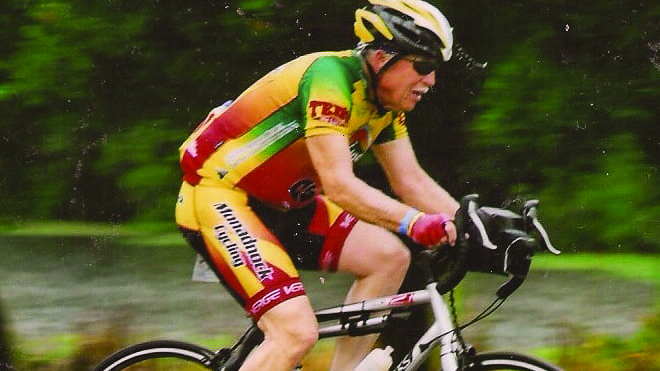For Lee Hawkes ’60, a 27-speed bicycle is a ticket to long-distance adventures and clarity of mind
Retirement has not slowed down Lee Hawkes ’60. A mechanical engineer whose career brought him to London, Singapore, and Hong Kong, the 76-year-old now explores the world from the saddle of a 27-speed road bicycle. His two-wheeled adventures include a traverse of Utah, a trek through the Canadian Rockies, a ride across Yellowstone National Park, and an epic two-month, 2,900-mile coast-to-coast pedal from San Diego to St. Augustine, Florida. Last spring, in the company of his brother-in-law Tom and sister-in-law Linda, who are his frequent riding partners, he journeyed some 1,300 miles up the Mississippi River from the Gulf of Mexico all the way to Wisconsin. We caught up with Hawkes at home in Massachusetts just before he departed for Mexico, where he spends six months of the year.
How do you choose your routes?
For the Mississippi trip, Tom, Linda, and I followed something called the Mississippi River Trail (MRT). Sometimes you ride along a bike path on top of levees, sometimes you get off the levees and are on roads next to the river, sometimes you go inland because it’s all swampy close to the river and you don’t have any roads. I set up our daily routes using a marvelous app called Ride With GPS. On my bike I have a little Bluetooth speaker and a handlebar mount for my iPhone. As you come up on turns, Ride with GPS says, “You’re going to turn left in a mile.” That made it very easy. We didn’t get lost. Actually, we did get lost a couple times, but that was when we deviated from the MRT because I thought I was smarter than the GPS and ended up on roads that turned out to be horrible.
What is it like riding along the Mississippi?
It was really interesting to see how the river is used for commerce, all the tugboats and barges and all the different industries. One tugboat would be pushing 10 enormous barges carrying very large quantities of grain and coal and gravel. You wouldn’t want to be out there in a sailboat.
Why does someone take up long-distance cycling? As you say in the book you wrote about your cross-country ride [Coast to Coast with Bubba’s Pampered Peddlers], most of your friends are playing golf and growing tomatoes.
Riding a bicycle is a wonderful kind of meditation. Getting through a three-hour ride really does cleanse your mind. After I retired, I went to Hong Kong University and did a master’s program in Buddhist studies. Most of the Buddhists I know would tell you that the lotus position is most effective for clearing one’s mind, but I never could do that for very long. In Buddhism, when thoughts come into your mind, you’re supposed to thank them very much and ask them to please go away. But I have things come into my mind and I like to chase them around. One of my other hobbies is making violins, and when I crossed the country I went through every single step of the process in my head. So that’s what I think about. I give myself a problem to solve. It’s probably not a great practice, because it means I’m not paying enough attention to the road!
What’s your next trip?
When I get back from Mexico, I’m thinking of moving out to Santa Fe, where there is very good infrastructure for cycling. I’ll spend summers there and winters in Mexico. There’s a group there called Seniors on Bikes, the Santa Fe SOBs. I currently belong to the Narragansett Bay Wheelmen, but they’re a bunch of young hotdogs. Riding with the SOBs makes more sense.
Lee’s Go-to Gear
- Smartphone loaded with the “Ride With GPS” app “Avid cyclists all know about Ride with GPS. You use the app to map your route before starting, then your phone plays it back to you as you ride. It’s just absolutely fantastic.”
- Rearview mirror “It’s very important to see traffic coming up behind you.”
- Good cycling clothing “Definitely get cycling gloves, shorts, and a jersey with all the pockets.”
- Hooded rain poncho “A poncho is preferable to a jacket, because the air circulates through it. In a jacket you’ll be wetter from sweat that won’t evaporate than from the rain.”
- Spare inner tube plus a pump or a CO2 cartridge “Obviously!”

